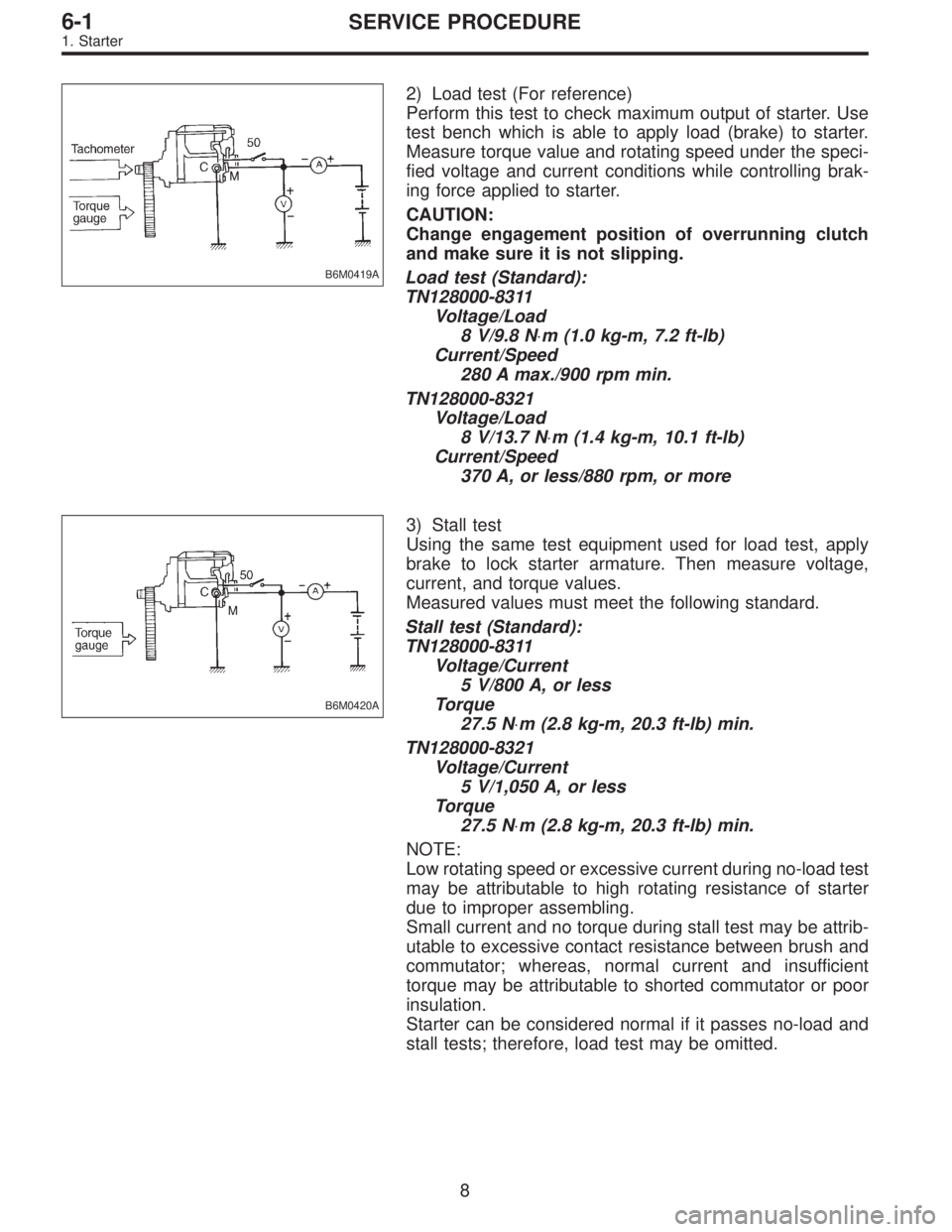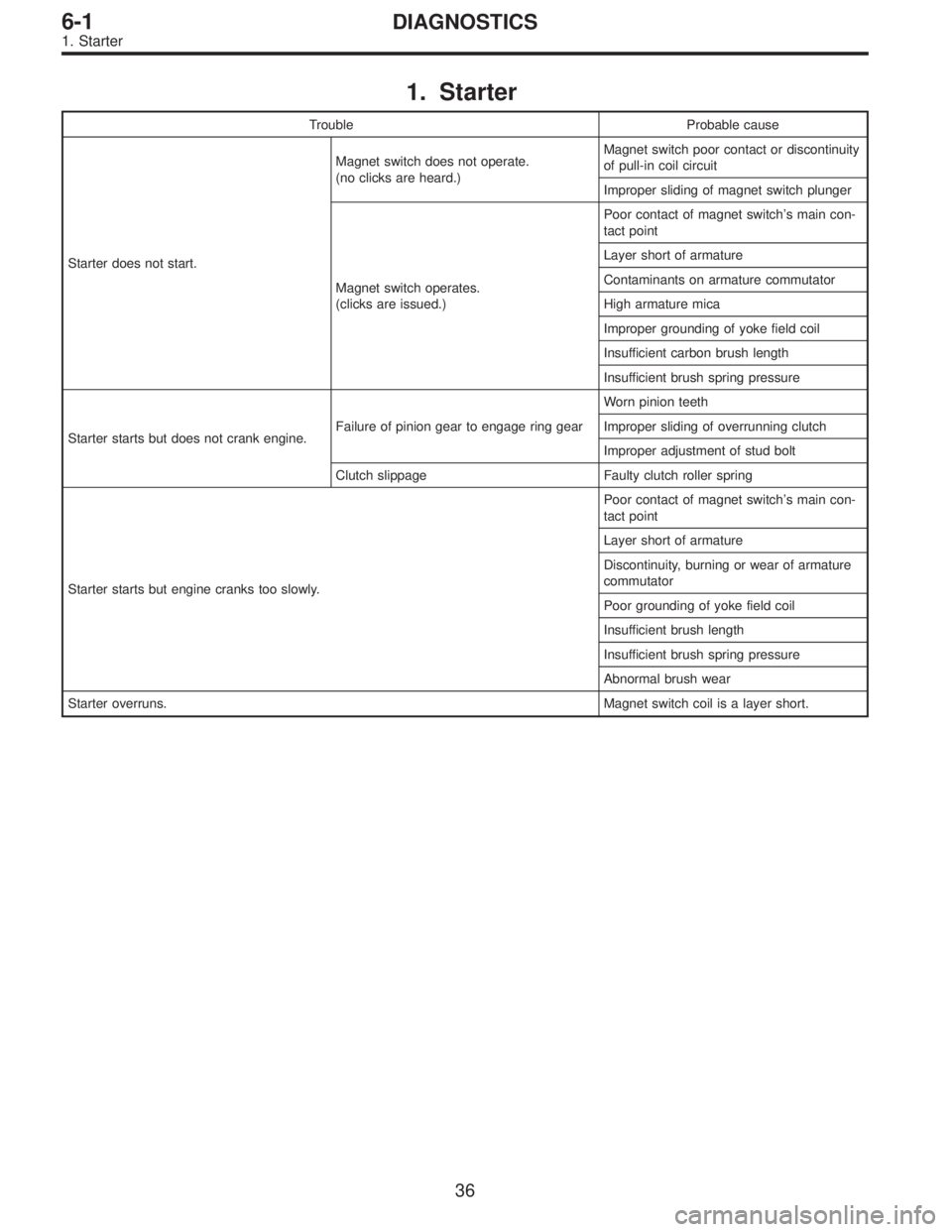Page 1616 of 2890
1. Starter
1. MT: 128000-8311
B6M0412A
�1Front ball bearing
�
2Armature
�
3Rear ball bearing
�
4O-ring
�
5Yoke
�
6Brush spring
�
7Brush holder
�
8End frame
�
9Screw & washer
�
10Cover
�
11Through bolt
�
12Screw & washer�
13Starter housing
�
14Overrunning clutch
�
15Steel ball
�
16Spring
�
17Retainer
�
18Roller
�
19Idle gear
�
20Nut
�
21Spring washer
�
22Magnet switch
�
23Nut
3
6-1COMPONENT PARTS
1. Starter
Page 1617 of 2890
2. AT: 128000-8321
B6M0413A
�1Front ball bearing
�
2Armature
�
3Rear ball bearing
�
4O-ring
�
5Yoke
�
6Brush spring
�
7Brush holder
�
8End frame
�
9Cover
�
10Screw & washer
�
11Through bolt
�
12Screw & washer�
13Starter housing
�
14Overrunning clutch
�
15Steel ball
�
16Spring
�
17Retainer
�
18Roller
�
19Idle gear
�
20Nut
�
21Spring washer
�
22Magnet switch
�
23Nut
4
6-1COMPONENT PARTS
1. Starter
Page 1621 of 2890

B6M0419A
2) Load test (For reference)
Perform this test to check maximum output of starter. Use
test bench which is able to apply load (brake) to starter.
Measure torque value and rotating speed under the speci-
fied voltage and current conditions while controlling brak-
ing force applied to starter.
CAUTION:
Change engagement position of overrunning clutch
and make sure it is not slipping.
Load test (Standard):
TN128000-8311
Voltage/Load
8 V/9.8 N⋅m (1.0 kg-m, 7.2 ft-lb)
Current/Speed
280 A max./900 rpm min.
TN128000-8321
Voltage/Load
8 V/13.7 N⋅m (1.4 kg-m, 10.1 ft-lb)
Current/Speed
370 A, or less/880 rpm, or more
B6M0420A
3) Stall test
Using the same test equipment used for load test, apply
brake to lock starter armature. Then measure voltage,
current, and torque values.
Measured values must meet the following standard.
Stall test (Standard):
TN128000-8311
Voltage/Current
5 V/800 A, or less
Torque
27.5 N⋅m (2.8 kg-m, 20.3 ft-lb) min.
TN128000-8321
Voltage/Current
5 V/1,050 A, or less
Torque
27.5 N⋅m (2.8 kg-m, 20.3 ft-lb) min.
NOTE:
Low rotating speed or excessive current during no-load test
may be attributable to high rotating resistance of starter
due to improper assembling.
Small current and no torque during stall test may be attrib-
utable to excessive contact resistance between brush and
commutator; whereas, normal current and insufficient
torque may be attributable to shorted commutator or poor
insulation.
Starter can be considered normal if it passes no-load and
stall tests; therefore, load test may be omitted.
8
6-1SERVICE PROCEDURE
1. Starter
Page 1623 of 2890
B6M0426A
6) Remove brush by lifting up positive (+) side brush
spring using long-nose pliers.
CAUTION:
Be careful not to damage brush and commutator.
B6M0427A
7) Remove armature from yoke.
CAUTION:
Be careful not to drop armature.
B6M0428A
8) Remove screws securing magnetic switch to housing.
B6M0429A
9) Remove housing from magnetic switch.
B6M0430A
10) Remove clutch from housing.
10
6-1SERVICE PROCEDURE
1. Starter
Page 1624 of 2890
B6M0431A
11) Take out steel ball from clutch.
CAUTION:
Be careful not to lose steel ball.
B6M0432A
12) Remove idle gear from housing.
B6M0433A
13) Remove retainer and roller from housing.
CAUTION:
Be careful not to drop retainer and roller.
B6M0434A
14) Remove coil spring from magnetic switch.
D: INSPECTION
1. ARMATURE
1) Check commutator for any sign of burns of rough sur-
faces or stepped wear. If wear is of a minor nature, correct
it by using sand paper.
11
6-1SERVICE PROCEDURE
1. Starter
Page 1626 of 2890

B6M0436
3. OVERRUNNING CLUTCH
Inspect teeth of pinion for wear and damage. Replace if it
is damaged. Rotate pinion in direction of rotation (clock-
wise). It should rotate smoothly. But in opposite direction,
it should be locked.
CAUTION:
Do not clean overrunning clutch with oil to prevent
grease from flowing out.
B6M0437
4. BRUSH AND BRUSH HOLDER
1) Brush length
Measure the brush length and replace if it exceeds the
service limit.
Replace if abnormal wear or cracks are noticed.
Brush length:
Standard 15 mm (0.59 in)
Service limit 10 mm (0.39 in)
2) Brush movement
Be sure brush moves smoothly inside brush holder.
B6M0438
3) Insulation resistance of brush holder
Be sure there is no continuity between brush holder and its
plate.
4) Brush spring force
Measure brush spring force with a spring scale. If it is less
than the service limit, replace brush spring.
Brush spring force:
Standard
18.6 N (1.9 kg, 4.2 lb) (when new)
Service limit
6.9 N (0.7 kg, 1.5 lb)
13
6-1SERVICE PROCEDURE
1. Starter
Page 1627 of 2890
B6M0439A
5. BEARING
1) Rotate bearing by hand; no binding should exist.
2) Rotate bearing rapidly; no abnormal noise should be
heard.
E: ASSEMBLY
Assembly is in the reverse order of disassembly proce-
dures. Observe the following:
1) Before assembling, lubricate disassembled parts at the
points shown in“COMPONENT PARTS 6-1 [C101] and 6-1
[C102]”.
Grease:
ESSO BEACON 325
SCHELL ALVANIA GREASE RA or equivalent
B6M0470A
2) Assembling magnetic switch, clutch, and housing
To assemble, first install clutch to magnetic switch, then
install idle gear, and finally install clutch.
CAUTION:
�Do not forget to install steel ball and coil spring to
clutch.
�Attach bearing to idle gear beforehand.
B6M0427A
3) Installing armature to yoke
CAUTION:
Do not forget to put felt washer on armature shaft bear-
ing.
B6M0471A
4) Installing brushes
Assemble brush holder to yoke as shown, then assemble
two yoke-side brushes to brush holder.
14
6-1SERVICE PROCEDURE
1. Starter
Page 1653 of 2890

1. Starter
Trouble Probable cause
Starter does not start.Magnet switch does not operate.
(no clicks are heard.)Magnet switch poor contact or discontinuity
of pull-in coil circuit
Improper sliding of magnet switch plunger
Magnet switch operates.
(clicks are issued.)Poor contact of magnet switch’s main con-
tact point
Layer short of armature
Contaminants on armature commutator
High armature mica
Improper grounding of yoke field coil
Insufficient carbon brush length
Insufficient brush spring pressure
Starter starts but does not crank engine.Failure of pinion gear to engage ring gearWorn pinion teeth
Improper sliding of overrunning clutch
Improper adjustment of stud bolt
Clutch slippage Faulty clutch roller spring
Starter starts but engine cranks too slowly.Poor contact of magnet switch’s main con-
tact point
Layer short of armature
Discontinuity, burning or wear of armature
commutator
Poor grounding of yoke field coil
Insufficient brush length
Insufficient brush spring pressure
Abnormal brush wear
Starter overruns.Magnet switch coil is a layer short.
36
6-1DIAGNOSTICS
1. Starter